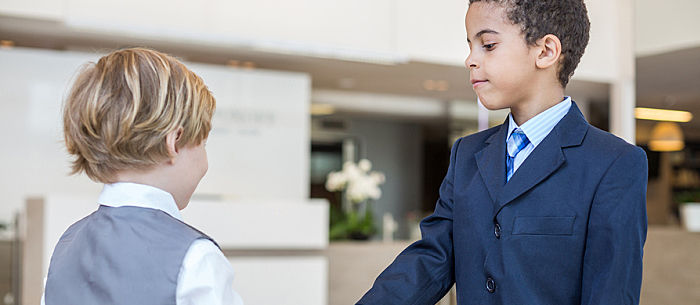It seems an article proclaiming the end of chivalry pops up every month, but chivalry isn’t dead. Modern chivalry, known as gentlemanly behavior, isn’t only applicable to males. While typically referencing men, the values represented by the term “chivalry” are important for everyone to learn, regardless of gender. It’s important that both boys and girls are taught the basic principles of courtesy, honor, reciprocity and ethical behavior.
It’s easy to see how technology created a barrier between people, eroding the rules of decorum “polite society” worked tirelessly to establish. Pennsylvania-based Lisa Richey, an etiquette expert, international speaker and the founder of The American Academy of Etiquette, says, however, it’s important to emphasize “the basics” when it comes to teaching children manners, including those associated with chivalry.
Here are lessons to teach your children that show chivalry isn’t dead and that gentlemanly behavior (treating people in a proper and polite way) is appropriate for both boys and girls (and that everyone, including girls, should practice and expect it!):
- Be Considerate of Others
Elaine Swann, a lifestyle and etiquette expert in Los Angeles, says teaching children to be considerate of others is “the core foundation of a child’s behavior, in many instances in life: at school, at home, at a restaurant.” Consideration is a concept that should be taught early and continually reinforced and modeled by parents.
- Communication
A significant part of your job as a parent is to teach your child the skills necessary for socialization.”We, as parents, have to make sure we’re doing everything we can to make sure we’re teaching [our children] to socialize,” says Swann. One of the ways parents can do this is to teach your child how to have a conversation with someone outside of family. “Teach children to respond in complete sentences,” adds Swann.
- Eye Contact
Richey explains that eye contact is not just good manners and chivalrous, it’s a sign of respect. Parents should also make it a practice to be at eye level with their children when they speak to them. Says Richey, “Eye contact is about putting your devices away and being fully present.” This, in turn, shows your children they’re valued and models respectful behavior for them.
- Introductions
Teaching your child the proper way to shake hands — which Richey says is to stand, make eye-to-eye contact and shake twice — is not only teaching social graces, it’s arming your child with confidence. Richey says that people should stand when they make an introduction, and parents can begin by teaching their child a basic introduction, such as “Hello, my name is __, what is yours?
- How To Eat
It seems a rudimentary skill, but teaching your child to eat is more than just table manners (which are great as well). Swann says, “We should be encouraging our children to get involved at dinner time. There are things we can do as parents to draw children into conversation, like committing to memory some of their friends or activities going on at school, and asking questions that are open-ended to encourage conversation.”Richey says that the loss of the family meal affects your children in unexpected ways. “Not only do you learn about table manners, but you learn about your family’s values when you’re sitting together.” See 7 Tips for Teaching Table Manners to Kids to start young.
- How To Say “Thank You”
Saying thank you in writing is an important skill to teach. “Writing thank-you notes can be done at even the youngest of ages,” says Swann. With younger children, Swann recommends creating an art-and-craft project to say “thank you,” and older children should begin drafting their own thank-you notes once they’re able to write.
Politeness, honesty and kindness have no gender boundaries. When you’re working with your child, Richey warns parents against nagging when teaching their children manners. Put it in context, says Richey, by asking your child, “How do you feel when someone is polite?” And most of all, says Richey, remind your children that “manners are a two-way street.” So practice and expect them!
What lessons do you feel it’s important for your children to learn? Tell us below and check out 27 Essential Manners for Kids to Learn for some ideas.
Lauren B. Stevens has been writing and sending thank-you notes since she was a child, and believes it to be a lost art. When she’s not teaching her preschool son to say please and thank you, Lauren writes about parenting for a myriad of online outlets, in addition to her blog, lo-wren.






